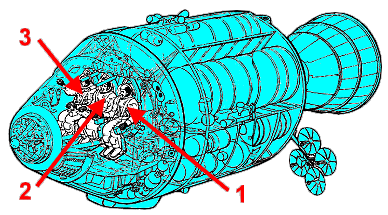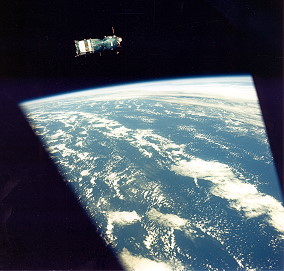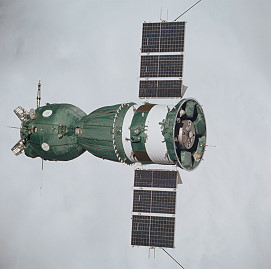Launch from Cape Canaveral and landing in the
Pacific Ocean near Hawaii. It was the first U.S.-U.S.S.R joint manned mission
Apollo-
Soyuz.
The
Command Module (CM) was a
conical pressure vessel with a maximum diameter of 3.9 m at its base and a
height of 3.65 m. It was made of an aluminum honeycomb sandwich bonded between
sheet aluminum alloy. The base of the CM consisted of a heat shield made of
brazed stainless steel honeycomb filled with a phenolic epoxy resin as an
ablative material and varied in thickness from 1.8 to 6.9 cm. At the tip of the
cone was a hatch and docking assembly designed to mate with the lunar module.
The CM was divided into three compartments. The forward compartment in the nose
of the cone held the three 25.4 m diameter main parachutes, two 5 m drogue
parachutes, and pilot mortar chutes for Earth landing. The aft compartment was
situated around the base of the CM and contained propellant tanks, reaction
control engines, wiring, and plumbing. The crew compartment comprised most of
the volume of the CM, approximately 6.17 cubic meters of space. Three astronaut
couches were lined up facing forward in the center of the compartment. A large
access hatch was situated above the center couch. A short access tunnel led to
the docking hatch in the CM nose. The crew compartment held the controls,
displays, navigation equipment and other systems used by the astronauts. The CM
had five windows: one in the access hatch, one next to each astronaut in the
two outer seats, and two forward-facing rendezvous windows. Five
silver/zinc-oxide batteries provided power after the CM and SM detached, three
for re-entry and after landing and two for vehicle separation and parachute
deployment. The CM had twelve 420 N nitrogen tetroxide/hydrazine reaction
control thrusters. The CM provided the re-entry capability at the end of the
mission after separation from the Service Module.
The
Service Module
(SM) was a cylinder 3.9 meters in diameter and 7.6 m long which was
attached to the back of the CM. The outer skin of the SM was formed of 2.5 cm
thick aluminum honeycomb panels. The interior was divided by milled aluminum
radial beams into six sections around a central cylinder. At the back of the SM
mounted in the central cylinder was a gimbal mounted re-startable hypergolic
liquid propellant 91,000 N engine and cone shaped engine nozzle. Attitude
control was provided by four identical banks of four 450 N reaction control
thrusters each spaced 90 degrees apart around the forward part of the SM. The
six sections of the SM held three 31-cell hydrogen oxygen fuel cells which
provided 28 volts, two cryogenic oxygen and two cryogenic hydrogen tanks, four
tanks for the main propulsion engine, two for fuel and two for oxidizer, and
the subsystems the main propulsion unit. Two helium tanks were mounted in the
central cylinder. Electrical power system radiators were at the top of the
cylinder and environmental control radiator panels spaced around the
bottom.
Jack
Swigert had originally been assigned as the command module
pilot for the
ASTP
prime crew, but prior to the official announcement he was removed as punishment
for his involvement in the
Apollo 15
postage stamp scandal.
This mission was the
first joint
U.S.–Soviet space flight, and the last flight of an
Apollo spacecraft. Its primary purpose was as a symbol
of the policy of détente that the two superpowers were pursuing at the
time, and marked the end of the Space Race between them that began in
1957.
The
Soyuz and
Apollo flights launched within seven-and-a-half hours.
The
Apollo Command & Service Module (
CSM) was launched with a docking module specially
designed to enable the two spacecraft to dock with each other, used only once
for this mission. The docking module was designed as both an airlock - as the
Apollo was pressurized at 5.0 psi using pure oxygen,
while the
Soyuz used a nitrogen/oxygen atmosphere at sea level
pressure - and an adapter, since the surplus
Apollo hardware used for the
ASTP
mission was not equipped with the APAS docking collar jointly developed by
NASA and the Soviet Academy of Sciences for the
mission. One end of the docking module was attached to the
Apollo using the same "probe-and-drogue" docking
mechanism used on the Lunar Module and the Skylab space station, while its
other end had the APAS docking collar, which
Soyuz 19 carried in place of the
standard
Soyuz/
Salyut system of the time. The APAS fitting with the
Soyuz 19 was releasable, allowing the
two spacecraft to separate.
The
Apollo spacecraft docked with
Soyuz 19. The docking adapter had
been carried through
Apollo. It was the first docking in space history
between two spacecraft launched from different countries. 44 hours of docked
joint activities which included 4 crew transfers between the
Apollo and the
Soyuz followed. The mission included both joint and
separate scientific experiments (including an engineered eclipse of the Sun by
Apollo to allow
Soyuz to take photographs of the solar corona), and
provided useful engineering experience for future joint US–Russian space
flights.
After separation of the spacecrafts a second docking with
Soyuz 19 as the active spacecraft was
done, but no more crew transfers. After the final separating the
Apollo crew accomplished 23 different scientific
experiments, as earth observation, experiments in the multipurpose furnace
(MA-010), extreme ultraviolet surveying (MA-083), crystal growth (MA-085), a
helium glow experiment (MA-088), a doppler tracking experiment (MA-089) and
geodynamics experiment (MA-128).
The only serious problem was during
reentry and splashdown of the
Apollo craft, during which the crew were accidentally
exposed to toxic nitrogen tetroxide fumes, caused by the reaction control
system (
RCS) oxidizer) venting from the spacecraft and
reentering a cabin air intake. The
RCS was inadvertently left on during descent, and
highly toxic nitrogen tetroxide was sucked into the spacecraft as it drew in
outside air. Vance
Brand
briefly lost consciousness, while Thomas
Stafford retrieved emergency oxygen masks, put one on Vance
Brand, and gave one to Donald
Slayton. The three astronauts were hospitalized for two weeks
in Honolulu.
The recovery ship was the
USS New
Orleans. This was the last
NASA mission for several years. The
Apollo program ended.
![]()




![]()



























